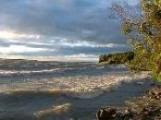Simcoe - fishing for clues on how to protect drinking water
The Lake Simcoe Region Conservation Authority has been fishing for clues on how to protect drinking water.
Scientists from the conservation authority and the Geological Survey of Canada (Atlantic) joined an American oceanographer on a trip to scan the bed of Lake Simcoe’s Kempenfelt Bay.
“Water quality issues in Ontario have been brought to light, and we don’t have as good an understanding of our groundwater resources as we’d like, in order to manage them properly. There are a lot of future groundwater quality and quantity questions. For example, are the wells in Barrie going to be able to supply the growing population?” said Don Goodyear, the LSRCA’s groundwater protection program manager.
“The building blocks for groundwater management (start with) a really good understanding of geology. We need to understand the interactions between the lake and the groundwater and this (expedition) is filling big voids in information.”
Oceanographers and hydrogeologists have theorized water from aquifers works its way into Lake Simcoe, said Goodyear. “You have cold water bubbling up in the middle of the lake. It’s critical for fish habitat,” he said, adding its temperature is about 6 degrees Celsius. “We will find out if what we suspect are areas of groundwater discharge are. Those are critical for lake trout.”
Dr. Mike Lewis and Dr. John King joined the research product to map not only Kempenfelt Bay’s bed, but the layers underneath it.
“If you look at what’s happened in Lake Simcoe over the past 12,000 years, it’s relevant to the Great Lakes, and it’s easier to study Lake Simcoe than the lakes,” noted King, from the University of Rhode Island’s graduate school of oceanography.
Scientists will collect sediment samples and also use radar to scan the structure beneath the lake, which they know to be the same as that of the Great Lakes, because the entire area was once covered by the ancient glacial Lake Algonquin. The findings will reveal patterns of development, as well as groundwater movement, and the effect of climate on the lakes. A dry period lowered the lake’s level 8,000 to 9,000 years ago.
“We’re doing a study of Kempenfelt Bay using various technologies and methods, and perhaps it’s a model for Lake Simcoe,” Lewis said.
The top seven metres of the lake bed, he noted, details the development of present-day Lake Simcoe, while further underground, the characteristics of life, water and climate on the older lake can be seen. Scientists already have some sonar data, but are looking for more detail and confirmation of a model they’ve created




1 Comments:
House Relocation Services Hyderabad
Bike Transportation Services hyderabad
Car Transportation Services hyderabad
International Packers and Movers Hyderabad
Cargo Services in Hyderabad
Post a Comment
<< Home